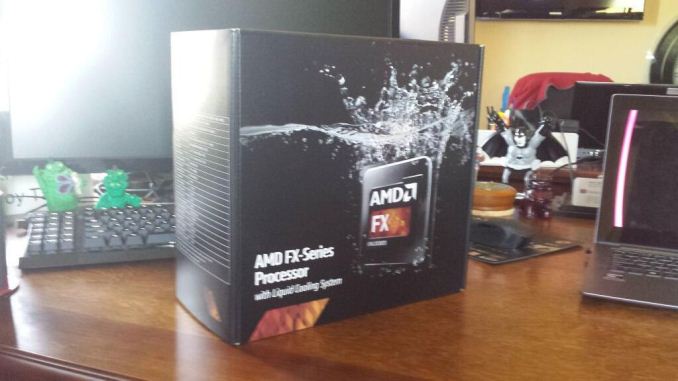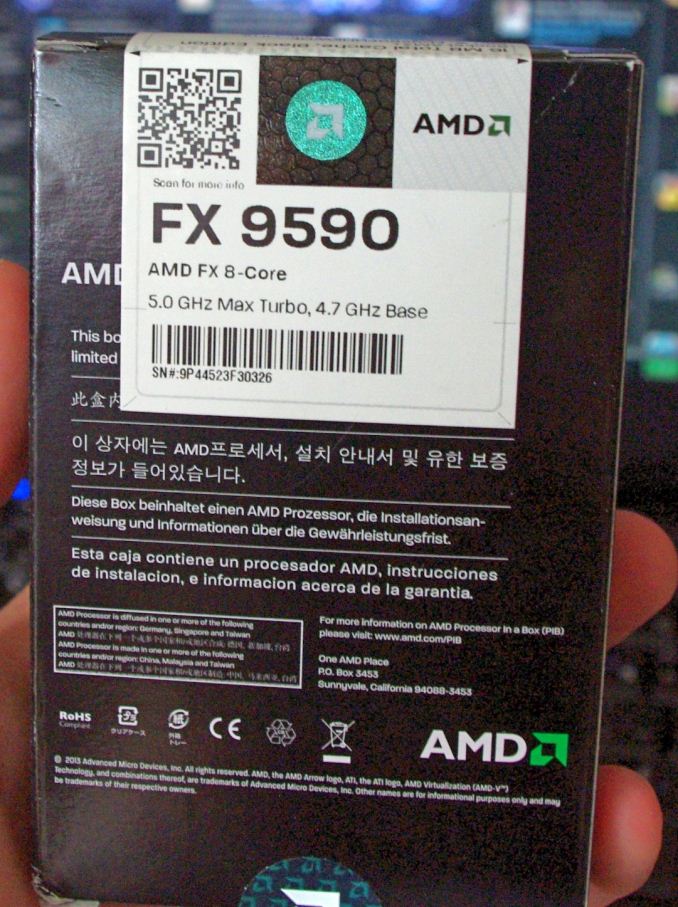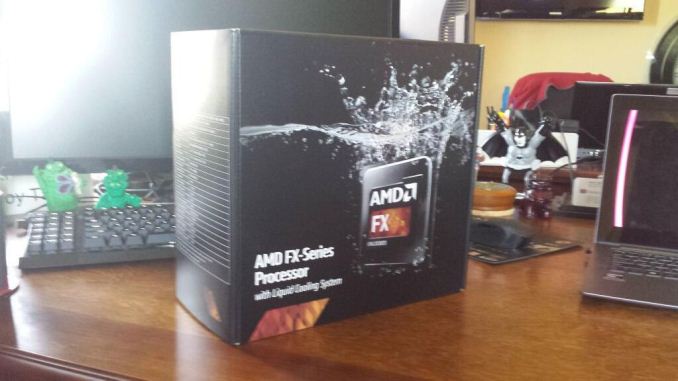AMD’s 5 GHz Turbo CPU in Retail: The FX-9590 and ASRock 990FX Extreme9 Review
by Ian Cutress on August 9, 2014 8:00 AM EST
While AMD’s FX-9590 CPU has been in systems for over a year, it suddenly comes to market as a retail package for end-users to buy with a bundled liquid cooling system. This 220W CPU that has a turbo speed of 5.0 GHz still sits at the top of AMD’s performance stack, despite subsequent improvements in the architecture since. We have decided to grab ASRock’s 990FX Extreme9 and an FX-9590 for a review to see if it still is the AMD performance CPU champion.
Spot the CPU
The story behind AMD’s fastest ever x86 CPUs is slightly odd. Two models, the FX-9590 and FX-9370, were both launched into OEM channels in June 2013. Being an OEM component, the only way to get one was in a pre-built system through a retailer, or through a bulk system integrator that had a model around one of these CPUs. Typically this is a process that is only exhibited with server class processors: from a range of CPUs being produced, only several will be available for end-users at retail because server CPUs usually go through a system builder. At the time, it seemed that AMD concerned that the high TDP of this CPU, at 220W listed, is too much for most cooling setups within a home user system and the best way to get it to consumers would be if a system builder chose the appropriate cooling for them.
As a result of this orientation of sales, AMD did not sample the media with review units. We review an AMD product typically though an AMD sourced sample. It was also noted that the OEM price for the CPU was near $900 for the FX-9590, which seemed like an excruciating amount for what was essentially a good overclocking version of the FX-8350. Several media websites were able to collaborate with system builders in order to get a chance to review the CPU, and AMD was confident in their promotion and handling of the new CPU.
Anecdotally, in my field of vision, the promotion of this CPU was relatively limited. The price was the main factor, resulting in comparative AMD/Intel systems being more power hungry on the AMD side, and substantially more expensive when put up against the latest mainstream i7 at the time. As a result, while some retailers were selling the OEM CPU at full price, some retailers decided to sell their OEM stock with a severe price cut directly to consumers, down from $900 to $390, in order to get rid of units (this is when I picked up our sample).
Due to the OEM nature of these sales to end-users, each CPU had either no warranty with AMD or a limited warranty. For the user interested in a 3-year system cycle without the fear of a bad egg, the OEM route is never a positive one.
AMD subsequently released, relatively silently, a proper package and retail version of the FX processors. It was apparent that this was in response to the OEM sales, with the retailers list ‘heatsink and fan not included’ alongside the specifications.
| AMD FX CPU Comparison | ||||||
|
FX- 4350 |
FX- 6350 |
FX- 8320 |
FX- 8350 |
FX- 9370 |
FX- 9590 |
|
| Release Date |
April 2013 |
October 2012 | October 2012 | October 2012 | June 2013 | June 2013 |
| Modules | 2 | 3 | 4 | |||
| L1 Cache (Code) | 128 KB | 192 KB | 256 KB | |||
| L1 Cache (Data) | 64 KB | 96 KB | 128 KB | |||
| L2 Cache | 4 MB | 6 MB | 8 MB | |||
| L3 Cache | 8 MB | |||||
| TDP | 125W | 220 W | ||||
| Base Frequency | 4200 | 3900 | 3500 | 4000 | 4400 | 4700 |
| Turbo Frequency | 4300 | 4200 | 4000 | 4200 | 4700 | 5000 |
| Core Name | Vishera | |||||
| Microarchitecture | Piledriver | |||||
| Socket | AM3+ | |||||
| Memory Support | DDR3-1866 | |||||
| Price (US) | $140 | $140 | $160 | $190 |
$230 $300 CLC |
$300 $370 CLC |
Since that release, AMD has not upgraded their enthusiast processor line with the latest architecture. The FX line has stayed where it is, perhaps for a number of reasons. One could speculate that releasing the next generation of FX-85xx might put them behind the FX-9590 in performance, or that the fabrication process was not suitable for a quad-module CPU with the new architecture improvements. The FX line for desktops, as far as we know, is staying at 32nm with no improvements.
Now Available
Fast forward twelve months to June 20th 2014 and Roy Taylor, AMD’s VP of Global Channel Sales tweets this innocuous picture:
Speculation was rife as to what this was. Here is a large box for an FX processor with the words ‘with Liquid Cooling System’ underneath. AMD supplied liquid cooling to the media when we reviewed the FX-8350 CPUs, the main CPU that sits underneath the FX-9590 and FX-9370, so there was an expectation that was something new.
On June 26th, the @AMDFX twitter account posted the following, confirming that this was the older FX-9590 but in a retail box with retail cooling:
To celebrate the start of ‘Round of 16’, we’re giving away eleven FX-9590 CPUs! #FXCUP pic.twitter.com/21JRaHdMq8 — AMD FX (@AMDFX) June 26, 2014
The AMD FX Processor page has been updated accordingly, showing the same render of the new box. Here we see that the liquid cooler is supplied by Cooler Master, and uses a wide range PWM fan as part of the package.
Of course, this leaves several questions unanswered: how much, when is it on sale, where is it on sale, and is it still any good? Well for the US at least, it is on sale today from Newegg at $370 with the water cooling kit, or $330 without. NCIX has it listed for CAD$500, although this is currently in ‘back stock’ mode.
The SKU to look for is the FD9590FHHKWOX, which in the UK does not seem to be on the shelves as of yet. Amusingly, when this is typed in to Google, the search engine asked me if I meant FD9590FHHKWOF, the non-CLC version.
This Review
Back when the FX-9590 was originally released alongside the FX-9370, we were unable to secure a sample from AMD and the limited availability made us feel the CPU had a fairly limited scope for testing. However, now the landscape has changed. There has been no new FX CPUs on the market from AMD, and this subsequent release of a retail version piques the interest as to how relevant AMD still sees their high-frequency part. Because I now have a FX-9590 all of my own to test from when the OEM stock was sold, I felt it was worth revisiting to see if it can be considered an investment.
Alongside testing this CPU, the 220W TDP requires a substantial motherboard to match. Due to the age of the platform, the AM3+ socket and the old 990FX chipset, finding a motherboard can be rather tricky. Many of the AM3+ motherboards that were launched were only suited for the FX-8350 processors, which had a 125W TDP. This is yet another reason that AMD wanted the FX-9590 in the hands of system builders who would chose high end motherboards that could cope.
Two of the newest motherboards to be released for 990FX were the ASRock 990FX Killer and the ASRock 990FX Extreme9. We reported the release of the Killer in December 2013, but the Killer is unsuitable here as the specification sheet lists processors up to 125W only. The Extreme9 is ASRock’s high-end AM3+ motherboard, and more suited to the task. Luckily I had requested a sample almost a year ago for some regression testing, so we will be reviewing this motherboard as part of this article.














146 Comments
View All Comments
wurizen - Saturday, August 9, 2014 - link
the fx series does need to go down in watts, which only comes in a die shrink from what i know. but the thing it has going for it are 8 cores, which intel doesn't even have in their consumer or enthusiast cpu's. u have to go xeon to find an intel 8 core cpu. my theory that amd is not updating the fx series or their chipsets is probably due to the backlash of the of fx series. i forgot when the the fx-8150 came out but it was negative. i don't think amd wants to have another repeat of that so amd is putting their cards back in the deck. they're softly announcing this and that about apu's... and hoping the marketing of apu will be enough to garner positive feedback. bring the image back. that is all it is, i think. what the hell is an apu, anyway? oh, it's the future. this is what amd wants ppl to know. but, we know that apu is not the future. it's just a stop gap for amd. it's just a fancy acronym.i don't think the low performance of amd fx cpu compared to an intel part is also solely amd's fault. i think software developers/coding can also be attributed to it. i mean, if you have this and that code built for intel chips since they're inside (i hate to say it) most of the pc's in the world, then of course, intel will have a lead from the get go. for example, windows 8 is suppose to be better for amd fx cpu's than windows 7. now dig deeper into how programs are run and make it so that an fx chip will shine as much as an intel chip, then we probably have a very well optimized program, which in the real world is probably a unicorn program. so, this unicorn program puts both amd and intel chips thru its paces, equally and optimally and fully. and i think that unless an intel chip has a specific function that makes it run faster (i forgot what it is), then an amd fx 8-core chip with its more logical, fully functional, real cores of 8 will probably be better than intels 4 cores with hyperhtreading. intel has patents for those specific, specialize tasks though and this is why intel is hard to beat and why amd loses to them.
this is why amd is waiting b/c 1)amd knows intel's roadmap and 2)they have apu's and consoles as stop gap 3) they'll return to the desktop performance cpu when the tide, the program/software/patents or whatever it is has leveled out so that amd can put out a competitive product that is truly innovative. and not just tick and tocks 4) the cpu fabs are probably too expensive right now for amd to jump in and do a die shrink (not sure tho; maybe intel has a hand in that too? idk)--like why is intel the only cpu company doing die shrinks every year and half? sounds weird to me. and it's closest competitor is just sitting back. weird right? anyway, im out of theories, i think.
oh, you'd think amd would just put 8 core kaveris without an igpu, right? but, no. i think amd is still not sure the performance gain with that will be enough to wipe out the negativity of the fx-8150 debacle. so, amd is just not doing it.
what do you guys think of my theories?
Death666Angel - Sunday, August 10, 2014 - link
"but the thing it has going for it are 8 cores, which intel doesn't even have in their consumer or enthusiast cpu's."I stopped reading right there. If you think 8 cores in a 4 module FX CPU are comparable to 4 cores in Intel mainstream CPUs or 8 cores in Intel enthusiast CPUs, you should go back and read up on the architecture differences. The fact that an Intel 8 thread CPU (core i7 with 4 cores and HT) usually beats any FX CPU with 4 modules should be warning enough that you shouldn't draw any conclusions based on that.
wurizen - Sunday, August 10, 2014 - link
Ive read up on bulldozer architecture. 4 modules with 2 logical and physical cores = 8 cores. Intels hyperthreading arent physical cores but software driven. so an OS sees an i7 with 8 cores even tho 4 of those cores are virtual. AMD has 8 physical/logical cores. Each module or 2 cores do have to share FpU, l2 cache (i think) and another thing. So, the cores are hampered by this but it doesnt take away the fact that there are 8 cores there. And i know its slow even though it has more cores than intel. But by refining it and better software optimization, i am wishing AMD to at least compete with intel enthusiast x99 chipset in the future with half the price. Why? Bc i cant afford intel. Simple as that.mapesdhs - Tuesday, August 12, 2014 - link
Sorry it's not an 8-core at all, not when it has to share resources split int vs. fp. Hence whythis very article shows again and again the older 4770K beating the 959 on threaded loads,
with 60% less power consumption. Convincing yourself that AMD's "8 cores" marketing has
any kind of sensible basis is as bad as believing MHz is an equally useful metric, or MIPS.
Intel's real, old, 6-core, the 3930K, utterly demolishes the 9590, for less power, etc. If you're
on a budget, buy a used 3930K, it'll leave AMD's chips in the dust, and there are plenty of
low cost X79 boards these days, especially on the used market (Gigabyte UD3 only cost me
55 UKP).
Ian.
Budburnicus - Wednesday, January 14, 2015 - link
Noob, 2x ALU per unit DOES NOT equal 2 FULL CPU cores! The ONLY "edge" AMD has gained by this, frankly, AWFUL architecture, is in marketing, because they can somehow LEGALLY call each unit 2 CPU cores - when they do not function as such at all! In fact, HyperThreading provides better real world performance that doubling APU's when the architecture involved has much higher IPC as well as a DEDICATED minimum of 168 GB/s to L3 cache per core, at stock speeds!AMD calling a 4 unit CPU an 8 core machine is essentially the same as intel calling a 4 core i7 an 8 core CPU! HyperThreading is NOT software! read more about CPUs bro.
Budburnicus - Wednesday, January 14, 2015 - link
*than doubling ALUs*Budburnicus - Wednesday, January 14, 2015 - link
EXACTLY! +1Laststop311 - Monday, August 11, 2014 - link
you said intel has no non xeon 8 core cpu's. But haswell-e will have 8 core/16 thread. I currently run an i7-980x gulftown x58 system and will be replacing it with 8 core haswell-e. video production speed should sky rocket.mapesdhs - Tuesday, August 12, 2014 - link
That depends on what you're doing, which app, where the bottlenecks reside, etc.If you've already oc'd your 980X then you're starting from a pretty good baseline,
so don't expect HW-E to be that much better (NB: I have a 990X, a couple of 3930Ks,
4820K, seveal 2700Ks, etc.)
What really will help for you is the newer I/O provision, ie. SATA3, PCI Express, M.2, etc.
The non-Intel SATA3 controllers on X58 boards were pretty awful, especially Marvell.
And of course you can at least double your max RAM, which might be holding you back
somewhat if you're a heavy AE user.
Ian.
Arbie - Sunday, August 10, 2014 - link
I think 'ur' Shift key is broken.